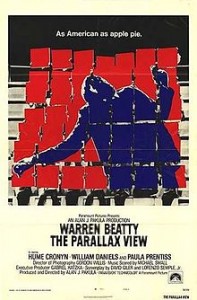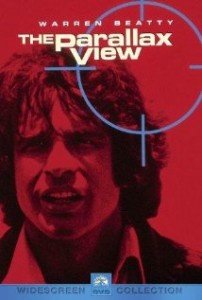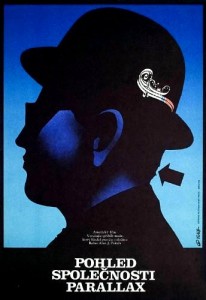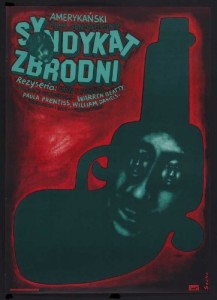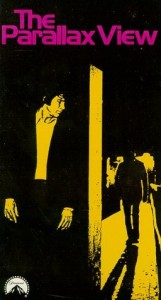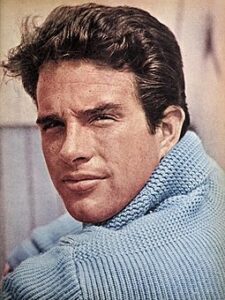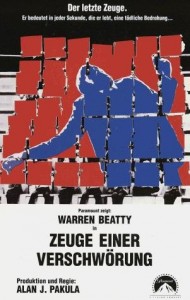The Parallax View ***** (1974, Warren Beatty, Paula Prentiss, William Daniels, Hume Cronyn, Walter McGinn, Anthony Zerbe, Kenneth Mars) – Classic Movie Review 1152
Alan J Pakula’s 1974 political paranoia conspiracy thriller film The Parallax View is brilliantly tense, taut and exciting. It’s a scorching nail-biter. Warren Beatty stars as an ambitious reporter who investigates a presidential candidate’s murder.
Producer-director Alan J Pakula’s 1974 political-paranoia conspiracy thriller film The Parallax View is brilliantly tense, taut and exciting. It’s a scorching nail-biter of a movie. Warren Beatty stars as ambitious newspaper reporter Joseph Frady, who is prompted to set out to investigate the murder of a presidential candidate.
His investigation turns out to be life endangering as it leads him on the trail to an obscure and enigmatic organization called the Parallax Corporation, whose primary hidden agenda turns out to be political assassination.
Paula Prentiss also stars as TV newswoman Lee Carter, one of many witnesses to the public assassination of Senator Charles Carroll (Bill Joyce) atop the Seattle Space Needle. Now, three years later, Carter visits her former boyfriend and colleague Frady and tells him she believes there is more to the assassination than was reported at the time. Six of the witnesses to Carroll’s assassination have since died, and she fears she will be next.
Frady (Beatty) takes up the story and gradually discovers evidence to suggest an evil organisation is in fact systematically eliminating witnesses to the candidate’s assassination in a story that cleverly plays on contemporary 70s audiences’ neuroses about President Kennedy’s assassination and President Nixon’s deceitful chicanery. Frady assumes false names to keep out of the way of the law and the agents of the evil organisation, and at one point is assumed dead, killed in an assassination attempt. His editor, sensing a good story when he hears it, is the only one who knows he is alive. Under another false name. Frady contacts the evil Parallax organisation to sign on as one of its killers.
In a strong, acting-required role, and ideally cast, the always underrated Beatty gives an excellent account of himself. It his his show, and a lot depends on him and how good he is – and he’s in there for it. Way too handsome and with way too much big hair, he is still entirely credible as a minor provincial reporter, who won’t give up on his story. He delivers his lines convincingly as though they are actual conversation, and is young and athletic enough to spring into the action when it’s needed: a fist fight, a car chase, a run from the law. There’s a superb character cast in loyal support, especially Hume Cronyn as his cynical newspaper editor Bill Rintels, a surprisingly tolerant and thoughtful character maybe, the nearest thing to a warm character in the entire movie, and William Daniels as the creepy Austin Tucker, whose life is being threatened but whom the hero is seeking out.
Walter McGinn, Anthony Zerbe, Kenneth Mars, Kelly Thordsen, Jim Davis and Bill McKinney co-star. None has too much to do, and most of them could do with more screen time, but they nevertheless make their mark. Jim Davis has remarkably big hair too. Well, it was the Seventies. Paula Prentiss’s role starts promisingly, but then vanishes.
And, above all, Pakula is well fired up and in command of all the film’s extraordinary ingredients, totally in his element with the Hitchcock-style material, delivering a wonderful Panavision style object of a film, with a series of thrilling set pieces, especially the chase atop the Seattle Space Needle, the dam sequence, and the finale at the rally of Senator George Hammond (Jim Davis). But others too: the bomb on the plane, the bomb on the boat, the police car chase.
There are plenty of ideas and food for thought flying around, but there is also a polished, exciting visual texture to the film, too, thanks to Gordon Willis’s distinctive anamorphic cinematography, using long lens, unconventional framing and shallow focus, and George Jenkins’s striking, polished production designs. Beatty is often shot from far off, with the idea that Frady is being watched. Willis seems to relish taking pleasure in filming almost every scene from as far away as possible, composing in the most eye-catching of shots. The bigger the screen to see the film on, the better. It was meant for the huge cinemas that still survived in the day. Oh, there were some great movies in the Seventies! And this is one of them.
David Giler, Lorenzo Semple Jr and (uncredited) Robert Towne’s sizzling screenplay is based on the 1970 novel by Loren Singer. Robert Towne did an uncredited rewrite on the screenplay. The novel’s idea about the killing of witnesses to the assassination John F Kennedy is changed in the screenplay to the killing of witnesses to the assassination of a fictional politician resembling Robert F Kennedy. Nevertheless, film director Alex Cox has called it the ‘best JFK conspiracy movie’.
Boldly, the film stops entirely for an assassin training montage, an idea that recalls Hitchcock’s Salvador Dali digression in Spellbound. Images in the clever montage between caption cards reading ‘LOVE’, ‘MOTHER’, ‘FATHER’, ‘HOME’, ‘ENEMY’, ‘HAPPINESS’ and ‘ME’ are either of anonymous people or famed real characters such as Richard Nixon, Adolf Hitler, Pope John XXIII, and Lee Harvey Oswald. The montage also includes Jack Kirby drawings from Marvel Comics’ Thor.
This was part two of Pakula’s unofficial political paranoia trilogy that began with Klute (1971) and ended with All the President’s Men (1976). It was the era of great paranoia political thrillers: the 1973 film Executive Action is another, and so is the 1974 film The Conversation) as well as Three Days of the Condor (1975).
It did not really receive its proper due and respect in its day, though the brilliant Gordon Willis won the Best Cinematography award from the National Society of Film Critics (USA). There is also a notable scored by Michael Small to pay some attention and respect to.
The cast
The cast are Warren Beatty as Joseph Frady, Paula Prentiss as Lee Carter, Hume Cronyn as Bill Rintels, William Daniels as Austin Tucker, Kenneth Mars as former FBI agent Will Turner, Walter McGinn as Jack Younger, Kelly Thordsen as Sheriff L D Wicker, Jim Davis as Senator George Hammond, Bill McKinney as Parallax assassin, Stacy Keach Sr as Commission Spokesman #1, Anthony Zerbe as Professor Nelson Schwartzkopf, William Jordan as Tucker’s aide, Edward Winter as Senator Jameson, Chuck Waters as Thomas Richard Linder, Earl Hindman as Deputy Red, William Joyce as Senator Charles Carroll, Jo Ann Harris as Frady’s girl Chrissy, Doria Cook-Nelson as Gale from Salmontail, Ford Rainey as Commission spokesman #2, and Richard Bull as Parallax goon.
The Parallax View is directed by Alan J Pakula, runs 102 minutes, is made by Gus Productions, Harbor Productions and Doubleday Productions, is distributed by Paramount Pictures, is written by David Giler and Lorenzo Semple Jr, based on the novel by Loren Singer, is produced by Alan J Pakula, is shot by Gordon Willis, and is scored by Michael Small.
Release date: June 19, 1974.
Alan J Pakula
Tragically, Alan Pakula died aged 70 on November 19 1998 in an appalling freak car accident on the Long Island Expressway in Melville, New York. A driver in front of him struck a metal pipe, which went through Pakula’s windshield, hit him in the head and caused him to swerve off the road and into a fence, killing him instantly.
Lorenzo Semple Jr
American writer Lorenzo Semple Jr died from natural causes at his home in Los Angeles, on March 28 2014, aged 91. He is known for his work on Papillon (1973), Three Days of the Condor (1975), The Drowning Pool, King Kong, Flash Gordon (1980) and Never Say Never Again (1983). He wrote the successful pilot episode for the 60s Batman TV series, wrote the first four episodes of the series based on it, and served as the series’ Executive Story Editor, as well as writing the 1966 Batman: The Movie feature film, completing the screenplay in 10 days.
© Derek Winnert 2014 Classic Film Review 1,152
Link to Derek Winnert’s home page for more film reviews: http://derekwinnert.com/

